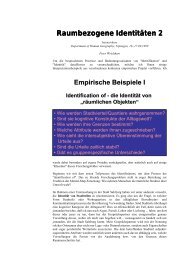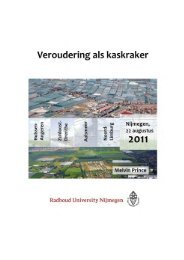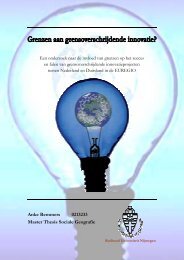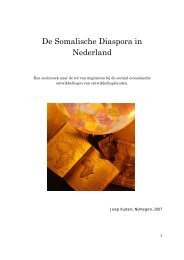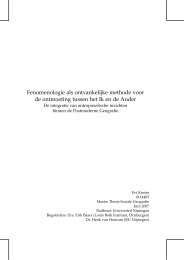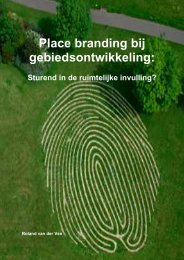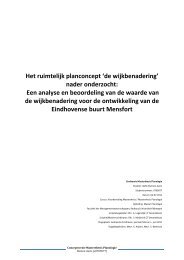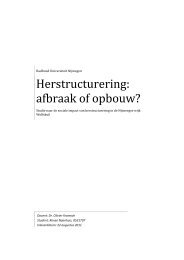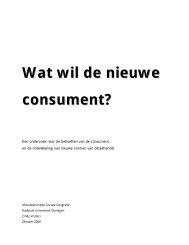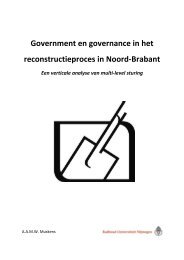Trading with the enemy in Mitrovica, Kosovo. - RUhosting
Trading with the enemy in Mitrovica, Kosovo. - RUhosting
Trading with the enemy in Mitrovica, Kosovo. - RUhosting
Create successful ePaper yourself
Turn your PDF publications into a flip-book with our unique Google optimized e-Paper software.
CHAPTER 5: RESULTS<br />
Plac<strong>in</strong>g <strong>in</strong>ter-ethnic relations and trade <strong>in</strong> <strong>Mitrovica</strong>'s context.<br />
In order to <strong>in</strong>terpret <strong>the</strong> results regard<strong>in</strong>g <strong>in</strong>ter-ethnic trade and relations, it is important to understand <strong>the</strong><br />
context <strong>in</strong> which <strong>the</strong>se are tak<strong>in</strong>g place. Relations between Albanians and Serbs have changed a lot <strong>the</strong> past<br />
decades, from areas <strong>in</strong> <strong>Kosovo</strong> where Albanians were often godparents to Serbian children (CARE, 2006) or<br />
places <strong>with</strong> less good relations like <strong>Mitrovica</strong> where <strong>the</strong>re was clear segregation (respondent # 2) to f<strong>in</strong>ally a<br />
complete dis<strong>in</strong>tegration of <strong>in</strong>ter-ethnic relations and a civil war. In <strong>the</strong> first part of this chapter <strong>the</strong> current<br />
state of <strong>in</strong>ter-ethnic relations will be described as well as <strong>the</strong> recent history, based on <strong>the</strong> experiences of local<br />
Albanians and Serbs. After this will be discussed <strong>in</strong> order: <strong>the</strong> role of reconciliation programmes and <strong>the</strong><br />
<strong>in</strong>ternational community, <strong>the</strong> economy, politics and <strong>the</strong> <strong>in</strong>ter-community rules affect<strong>in</strong>g trade and <strong>in</strong>ter-ethnic<br />
relations. The chapter will close <strong>with</strong> a short paragraph on how <strong>the</strong> here presented context shapes trade and<br />
<strong>in</strong>ter-ethnic relations <strong>in</strong> <strong>Mitrovica</strong>.<br />
5.1. Current <strong>in</strong>ter-ethnic relations <strong>in</strong> <strong>Kosovo</strong> and <strong>Mitrovica</strong>.<br />
This paragraph will discuss <strong>the</strong> current <strong>in</strong>ter-ethnic relations <strong>in</strong> <strong>Kosovo</strong> and <strong>Mitrovica</strong> specifically, from a<br />
perspective of <strong>the</strong> local population and members of <strong>the</strong> <strong>in</strong>ternational community present <strong>in</strong> <strong>Kosovo</strong>. It is<br />
divided <strong>in</strong> a part focuss<strong>in</strong>g on how <strong>the</strong>re relations have developed and a part on how <strong>the</strong>se relations are now.<br />
5.1.1. How <strong>in</strong>ter-ethnic relations have developed over <strong>the</strong> past 30 years.<br />
This description of <strong>in</strong>ter-ethnic relations <strong>in</strong> <strong>Kosovo</strong> will start <strong>in</strong> <strong>the</strong> 1980s for two reasons. The first be<strong>in</strong>g<br />
that dur<strong>in</strong>g <strong>the</strong> 1980s relations between Albanians and Serbs really started escalat<strong>in</strong>g, and <strong>the</strong> second be<strong>in</strong>g<br />
that based on <strong>the</strong> age of most of my respondents this is <strong>the</strong> far<strong>the</strong>st back most can still remember. In <strong>the</strong><br />
1980s <strong>the</strong>re were already tensions between Albanians and Serbs. Several Serbs remembered how <strong>the</strong>ir<br />
mo<strong>the</strong>rs carried weapons when br<strong>in</strong>g<strong>in</strong>g <strong>the</strong>ir kids to school <strong>in</strong> fear of Albanian attacks (field notes,<br />
respondent #2 & #4). Respondent #2, a Serb who lived his entire life <strong>in</strong> <strong>Mitrovica</strong> North, recalls not be<strong>in</strong>g<br />
able to go to school because of Albanian protests and fear of <strong>the</strong> police force which was <strong>the</strong>n mostly<br />
Albanian. Back <strong>the</strong>n some schools were divided <strong>in</strong>to an Albanian and a Serbian part, for example by a wall<br />
(respondent #1 & #4). People were be<strong>in</strong>g beaten up based on <strong>the</strong>ir ethnicity by <strong>the</strong> o<strong>the</strong>r group, <strong>in</strong> some<br />
cases even regularly (field notes, respondent #1 & #2). Although <strong>Mitrovica</strong> was still mixed back <strong>the</strong>n<br />
Albanians and Serbs lived very segregated, respondent #2 recalls: “it was not like Bosnia”. There was an<br />
unwritten rule that Albanians walked on <strong>the</strong> right side of <strong>the</strong> ma<strong>in</strong> street and Serbs on <strong>the</strong> left side. It was<br />
already divided <strong>the</strong>n, respondent #2 repeats, <strong>the</strong> only Albanians he had contact <strong>with</strong> were his neighbours.<br />
“<strong>Mitrovica</strong> was no paradise but it was ok”. This is <strong>in</strong> l<strong>in</strong>e <strong>with</strong> what o<strong>the</strong>r respondents told me, <strong>the</strong>y only<br />
had a few contacts of <strong>the</strong> o<strong>the</strong>r ethnicity and <strong>the</strong>se were ma<strong>in</strong>ly neighbours (field notes, respondent #1 & #4).<br />
Respondent #3, an Albanian woman orig<strong>in</strong>ally from <strong>Mitrovica</strong> North but now liv<strong>in</strong>g <strong>in</strong> South says she had a<br />
few good relationships <strong>with</strong> Serbs but also some bad ones. Especially when <strong>the</strong> tension <strong>in</strong>creased relations<br />
52



